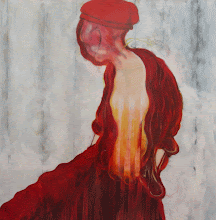‘The Glass Bead Game Has Started’ represents five years of collaborative internet work.
The original concept of the sculpture was based loosely on the novel “The Glass Bead Game” by Hermann Hesse in which subjects are debated from universal aspects of culture and science with a view to reaching harmonious outcomes. Geoff Sansbury chose a basic three dimensional five bar musical stave pivoted at its centre as the ‘board’ of play of the game; this was constructed both in real terms and as a computer generated model. The two areas either side of the conical pivot were allocated the fields of ‘linear’ and ‘non linear’ interpretations of artistic, scientific, mathematical and philosophical ideas. The first five moves and objects were performed and produced by the artist in both real and ‘virtual’ terms.
The game, in the form of a web site, was posted on the internet in 1996 and was due to terminate in 2000. Players were asked to either move current objects or to create and place objects on the virtual model. The artist endeavoured to reproduce these objects as real sculptural pieces that slid, rolled or acted as blocks to movement. Each movement and position of the objects was required to end in the balancing of the five bar stave before the next move could be made or the subsequent object brought into play. The positions of the objects on or between the five rods could then suggest raw musical notes which were logged in sequential fashion. The variations of this musical ‘theme’ were recorded alongside the logs of the movements and logs of created objects and their meanings.
All players were anonymous and some moves and objects were bizarre and even aggresive. The game was finally brought to a standstill by a deliberate virus invasion. The artist is currently working on a secondary game which documents and explores the more aggressive side of human nature which runs parallel to the creative act.
“Our dreams are lovely and our game is bright,
So finely tuned, with many artful turns,
But deep beneath the tranquil surface burns
Longing for blood, barbarity, and night.”
Glass Bead Game. Hermann Hesse. Translated by Richard and Clara Winston. 1987. Pan Books. P 431.

















